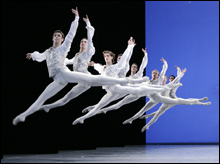
DIAMONDS: Does Balanchine’s gran design slip away? |
George Balanchine’s Jewels got a lukewarm critical reception when it premiered in 1967, though the public loved it right off for its triple-threat bravado. New York City Ballet wanted to create a festive work for its new home in Lincoln Center: the great choreographer disporting himself in three balletic modes, French (Emeralds/Fauré), American (Rubies/Stravinsky), and Russian (Diamonds/Tchaikovsky). Jewels has proved to be a durable masterpiece.The Paris Opera Ballet’s new DVD, Joyaux, produced by Opus Arte and distributed here by Naxos (and scheduled to air August 28 at 3 am as part of Great Performances on PBS), is the first complete recording of Jewels to enter general release, and for that alone Balanchine fans should be grateful. POB acquired Rubies (sometimes called Capriccio) in 1974 from one of its original leading dancers, Patricia Neary. Later on Karin von Aroldingen and Sara Leland taught Emeralds and Diamonds, and the whole spectacle was first performed in Paris in 2000. Christian Lacroix designed new costumes, which look a lot sleeker and less glitzy than Mme. Karinska’s originals.
These French dancers have the technical chops to do Balanchine, and the musicality besides. The video shows off their whizbang turns and assured balances, the clarity of their intricate step sequences, the expansive lifts and leaps, and the precise, demanding corps work. Their style, which is to say their interpretation of Balanchine’s challenge, is very objective, with an overlay of generic emoting. The corps grin all the way through Rubies, to show you they’re having a good time. The romantic couple in Diamonds gaze at each other soulfully, and in Emeralds there’s an air of open-mouthed intoxication.

On a documentary by filmmaker Reiner Moritz that’s part of the package, dancers and POB artistic director Brigitte Levèvre offer some vivid but not necessarily definitive insights. Rubies, for instance, is obviously based on Broadway musicals, they think. Maybe Balanchine got jazzed from his Broadway work in the ’30s, but he absorbed a lot of other Americanisms in his lifetime. I’ve always thought Rubies was more about circuses and musical-hall entertainments. Pat Neary and its other first principals, Patricia McBride and Edward Villella, were earthy, not above lowbrow escapades. I’m sure that’s why Balanchine chose them for this piece.
In fact, all the ballet’s original stars, including Violette Verdy, Mimi Paul, Suzanne Farrell, and Jacques d’Amboise, expressed NYCB’s diversity at the time. NYCB has become more standardized now; perhaps it’s an international trend.
When the ballet is intimate, like Emeralds, or compact and punchy, like Rubies, TV director Pierre Cavassilas brings the viewer into a welcome proximity with medium-distance shots and close-ups. When the choreography expands, though, he resorts to a variety of reductive alternatives and hyperactive interventions, like filming one-half of a symmetrical pattern, zeroing in on the center of a large group and eliminating the sides, switching from one partial-view camera position to another, and tracking a cluster of dancers as they move through groups of other dancers.
I’ve never understood this thinking. Even as these choreography-resistant techniques bring our attention to selected dancers and their expressive gloss, the ballet’s grand designs, its larger implications, slip away.
In Diamonds, for instance, we get a good account of the pas de deux (Agnès Letetsu and Jean-Guillaume Bart) and of some small ensemble sections. We taste how Balanchine used Tchaikovsky’s Third Symphony to evoke the composer’s other ballets, Swan Lake and Sleeping Beauty. In the opening shots, we catch the 12-woman corps de ballet dancing in a diamond-shaped floor pattern.
On stage, the ballet plays with scale, the interlocking possibilities of specialized units within the large cast of 24 corps members, eight demi-soloists, and two principals. Balanchine could miraculously expand and contract the panorama and at the same time transform the ensemble from 12 swanlike creatures to a regal, celebratory assemblage. Maybe television just isn’t up to that.